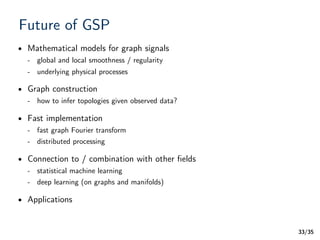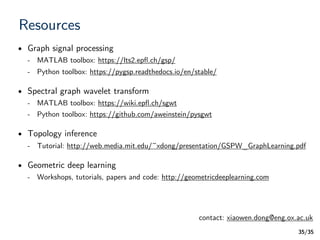This document discusses graph signal processing and its applications. It begins by motivating the need to analyze structured data as graphs rather than as independent points. It then introduces basic concepts in graph signal processing such as representing data as graph signals on vertices, defining the graph Laplacian, and generalizing the Fourier transform to the graph spectral domain. The document outlines applications of graph signal processing tools like spectral filtering to domains such as social networks, transportation, and biomedicine.
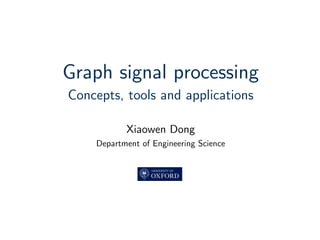
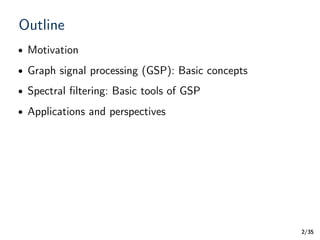



![/35
Graphs are appealing tools
4
l Efficient representations for pairwise relations between entities
The Königsberg Bridge Problem
[Leonhard Euler, 1736]](https://image.slidesharecdn.com/cdtguestlecturegsp-190420042645/85/Cdt-guest-lecture_gsp-6-320.jpg)





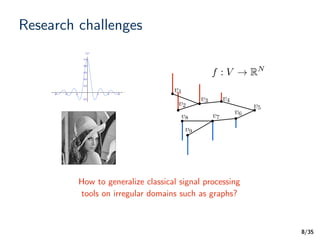
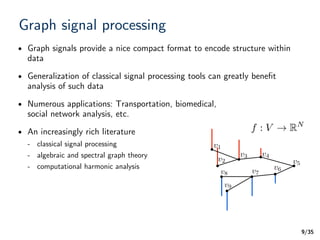
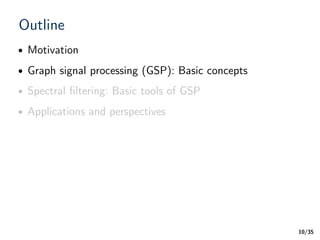

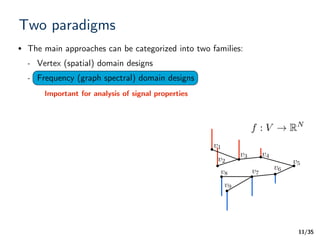


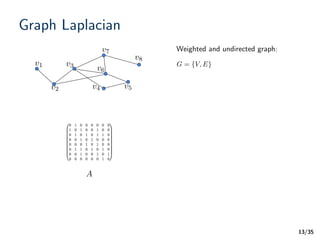



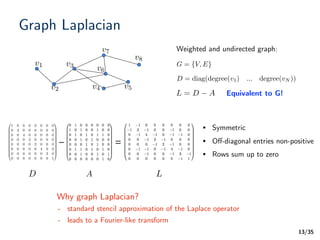
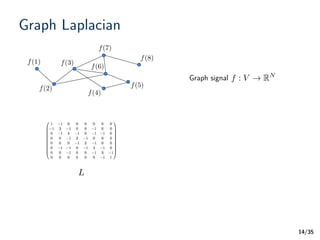

![/35
Graph Laplacian
14
f(1)
f(2)
f(3)
f(4)
f(5)
f(6)
f(7)
f(8)
A difference operator:
Graph signal
L
Laplacian quadratic form:
A measure of “smoothness” [Zhou04]
Lf =
NX
i,j=1
Aij (f(i) f(j))
fT
Lf =
1
2
NX
i,j=1
Aij (f(i) f(j))
2
f : V ! RN
f](https://image.slidesharecdn.com/cdtguestlecturegsp-190420042645/85/Cdt-guest-lecture_gsp-26-320.jpg)
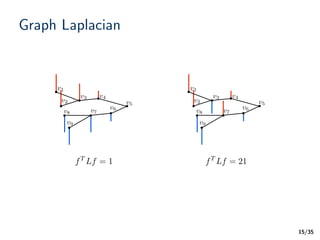

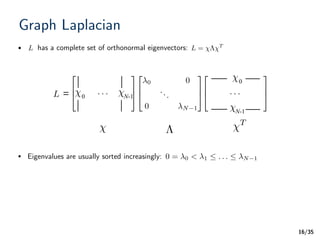
![/35
Graph Fourier transform
17
[Shuman13]0 501](https://image.slidesharecdn.com/cdtguestlecturegsp-190420042645/85/Cdt-guest-lecture_gsp-30-320.jpg)
![/35
Graph Fourier transform
17
[Shuman13]0 501
Low frequency High frequency
T
50L 50 = 50
l Eigenvectors associated with smaller eigenvalues have values that vary less rapidly
along the edges
L = ⇤ T T
0 L 0 = 0 = 0](https://image.slidesharecdn.com/cdtguestlecturegsp-190420042645/85/Cdt-guest-lecture_gsp-31-320.jpg)
![/35
Graph Fourier transform
17
[Shuman13]0 501
Low frequency High frequency
T
50L 50 = 50L = ⇤ T
fˆf(`) = h `, fi :
2
6
4
0 0
...
0 N 1
3
7
5· · ·0 N-1
T
Graph Fourier transform:
[Hammond11]
T
0 L 0 = 0 = 0](https://image.slidesharecdn.com/cdtguestlecturegsp-190420042645/85/Cdt-guest-lecture_gsp-32-320.jpg)
![/35
Graph Fourier transform
17
[Shuman13]0 501
Low frequency High frequency
T
50L 50 = 50L = ⇤ T
Low frequency High frequency
fˆf(`) = h `, fi :
2
6
4
0 0
...
0 N 1
3
7
5· · ·0 N-1
T
Graph Fourier transform:
[Hammond11]
0 4
· · ·
· · ·1 2 3 N 1
T
0 L 0 = 0 = 0](https://image.slidesharecdn.com/cdtguestlecturegsp-190420042645/85/Cdt-guest-lecture_gsp-33-320.jpg)




![/35
Two special cases
19
[Vandergheynst11]](https://image.slidesharecdn.com/cdtguestlecturegsp-190420042645/85/Cdt-guest-lecture_gsp-38-320.jpg)
![/35
Two special cases
20
[Vandergheynst11]](https://image.slidesharecdn.com/cdtguestlecturegsp-190420042645/85/Cdt-guest-lecture_gsp-39-320.jpg)
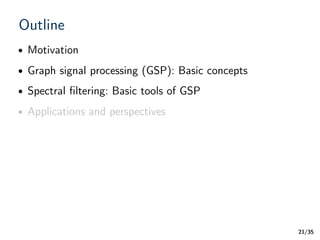



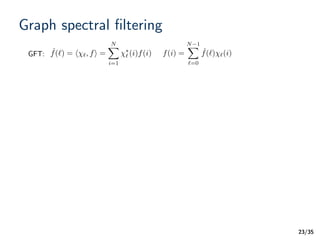

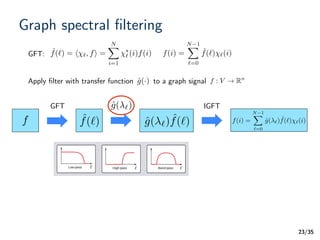

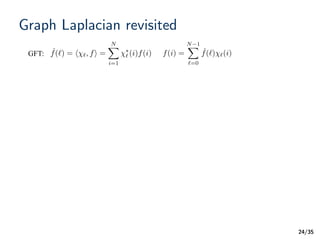


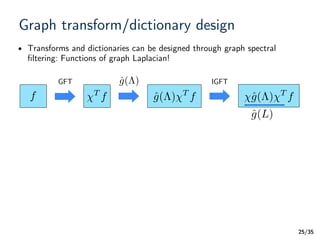
![/35
Graph transform/dictionary design
• Transforms and dictionaries can be designed through graph spectral
filtering: Functions of graph Laplacian!
25
GFT IGFT
f T
f ˆg(⇤) T
f ˆg(⇤) T
f
ˆg(⇤)
ˆg(L)
l Important properties can be achieved by properly defining , such
as localization of atoms
ˆg(L)
l Closely related to kernels and regularization on graphs [Smola03]](https://image.slidesharecdn.com/cdtguestlecturegsp-190420042645/85/Cdt-guest-lecture_gsp-52-320.jpg)
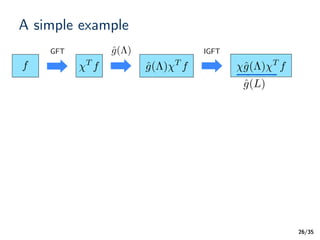
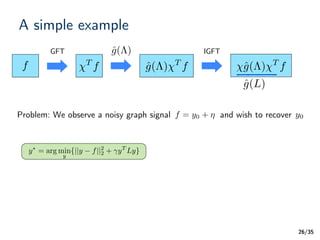

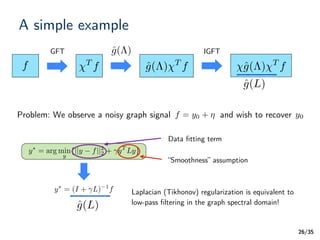
![/35
Example designs
• Consider a noisy image as the observed noisy graph signal
• Consider a regular grid graph (weights inv. prop. to pixel value difference)
27
[Shuman13]](https://image.slidesharecdn.com/cdtguestlecturegsp-190420042645/85/Cdt-guest-lecture_gsp-57-320.jpg)

![/35
Example designs
28
Low-pass filters:
Shifted and dilated band-pass filters: Spectral graph wavelets
Parametric polynomials:
Adapted kernels: Learn values of directly from data
GFT IGFT
f T
f ˆg(⇤) T
f ˆg(⇤) T
f
ˆg(⇤)
ˆg(L)
ˆg(L) = (I + L) 1
= (I + ⇤) 1 T
ˆgs(L) =
KX
k=0
↵skLk
= (
KX
k=0
↵sk⇤k
) T
ˆg(L) [Zhang12]
[Thanou14]
ˆg(sL) [Hammond11,
Shuman11, Dong13]
Window kernel: Windowed graph Fourier transform [Shuman12]](https://image.slidesharecdn.com/cdtguestlecturegsp-190420042645/85/Cdt-guest-lecture_gsp-59-320.jpg)
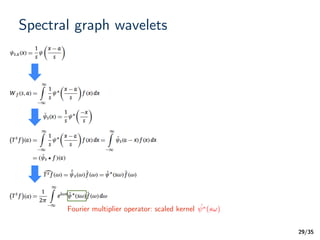




![/35
Spectral graph wavelets
30
[Hammond11]](https://image.slidesharecdn.com/cdtguestlecturegsp-190420042645/85/Cdt-guest-lecture_gsp-65-320.jpg)
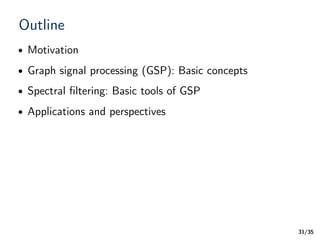
![/35
Applications of GSP
• Signal processing and machine learning tasks
- Denoising [Graichen15, Liu16]
- Semi-supervised learning / Classification [Kipf16, Manessi17]
- Clustering [Tremblay14, Tremblay16]
- Dimensionality reduction [Rui16]
32](https://image.slidesharecdn.com/cdtguestlecturegsp-190420042645/85/Cdt-guest-lecture_gsp-67-320.jpg)
![/35
Applications of GSP
• Signal processing and machine learning tasks
- Denoising [Graichen15, Liu16]
- Semi-supervised learning / Classification [Kipf16, Manessi17]
- Clustering [Tremblay14, Tremblay16]
- Dimensionality reduction [Rui16]
32
• Application domains
- Neuroimaging / Brain activity analysis [Huang16, Smith17, Ktena17]
- Social network analysis (e.g., community detection [Bruna17], recommendation
[Monti17], link prediction [Schlichtkrull17])
- Urban computing (e.g., mobility inference [Dong13])
- Computer graphics [Monti16, Yi16, Wang17, Simonovsky17]
- Geoscience and remote sensing [Bayram17]](https://image.slidesharecdn.com/cdtguestlecturegsp-190420042645/85/Cdt-guest-lecture_gsp-68-320.jpg)
